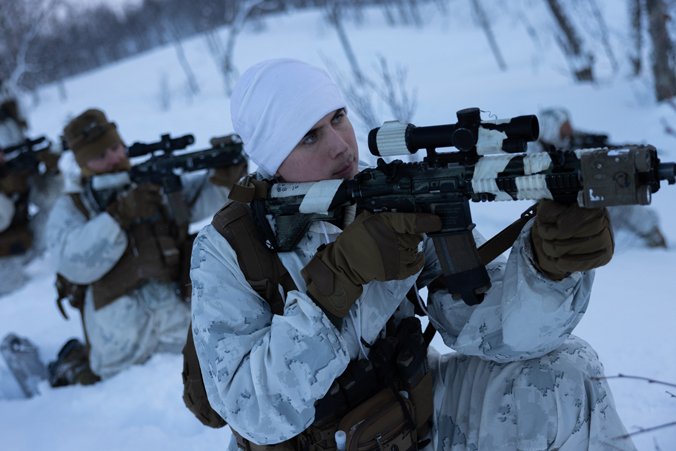The US Marines of 1st Battalion, 2nd Marine Regiment are heading to the northernmost part of Norway for exercise Nordic Response – part of NATO’s Steadfast Defender 24, the largest NATO exercise in decades. But before they get there, they’ll need to master the unforgiving Norwegian winter.
The marine looks down at his skis as if they’re going to bite him.
But his comrades won’t stop taunting him – do it, do it, do it – so he lifts his chin and eyes the drop before him with resolve. He plants his poles in the snow and pushes.
The marine glides down the slope – more like a dent, really, in the crown of this snowy hill in northern Norway – and almost reaches the bottom when his skis leap out from under him, sending him crashing onto his back.
His friends erupt in cheers, raising their mittened hands. The marine groans.
“Every time, I fall on my a**,” he says, using a word we can’t repeat on the NATO website.
Like many of the troops in 1st Battalion, 2nd Marine Regiment (1/2 for short), he’s never been on skis before. This 10-day cold weather training course, held in the hills near Setermoen in February 2024, is a trial by ice, designed to help the marines survive the extreme elements of the Arctic Circle. In a matter of weeks, 1/2 will be well north of here, landing on the frozen coasts of Norway’s remote Finnmark region, for exercise Nordic Response.
Norway has long been a cold-weather proving ground for NATO Allies. The “Cold Response” series of exercises began in 2006, building off a long legacy of cold-weather training in Norway. Since then, the exercise has taken place in northern Norway every other year.
Following NATO’s enlargements with Finland and Sweden, the Norwegians are now expanding the exercise and renaming it “Nordic Response”. It involves over 20,000 soldiers, 50+ ships and 110+ aircraft from more than 14 countries.
The fallen marine rises to his skis and duck-walks back up the hill. He might be grimacing now, but by the time the exercise starts, he’ll be skiing through the frozen landscape with ease, a rifle slung across his chest and a 30-kilogram rucksack hugging his back.
“I think that’s one of the things that we see with our marines and sailors in this training,” said Marine Lieutenant Colonel Ted Driscoll, 1/2’s Commander, “is how rapidly they can gain skills to meet a level of proficiency necessary to execute operations. But like anything, it just takes practice”.
Unless, of course, you were born here. Many Norwegian soldiers enter military service with plenty of cold-weather savvy, and they move through the punishing terrain with style, whether by ski, snowshoe or snow mobile. They see the uncompromising rigour of their great, snowy backyard as a valuable proving ground for NATO’s forces.
“Being in Finnmark, in the harsh temperatures, cold temperatures, lots of snow, it’s very hard to operate,” said Lieutenant Colonel Petter Bakkejord, Commander of the Norwegian Army’s Armoured Battalion, Brigade Nord. “That will enable us to operate anywhere in the world. It could be desert, it could be tropical areas, but the Arctic prepares you for most environments.”
Which is to say: if you can make it here, you can make it anywhere.
Not that you need to tell the marines. In the past decade, the US military’s amphibious force has dedicated itself to mastering arctic warfare, sending scores of troops to learn the harsh lessons of winter in Setermoen. They’ve had good teachers in their Norwegian counterparts, and also the United Kingdom’s Royal Marines, which have a relationship with the Norwegian Arctic that predates NATO itself (in 1941, Royal Marine Commandos raided the Axis-occupied Lotofen islands, not far from Setermoen).
At their hilltop camp, you could see years’ worth of lessons learned being put into practice. For example: a marine shovelling snow into a yellow plastic bag. What might look like a menial chore is, in fact, the most important task in the camp. Snow gets melted and then boiled into clean water, which cooks food and hydrates marines. If someone isn’t digging a fighting position, brushing snow off their weapon or tuning skis, they’re shovelling snow into bags, or turning snow into water.
The trick is to keep busy. There’s always something to do, and doing that something generates body heat, keeping the -20 degrees Celsius (-4 degrees Fahrenheit) cold from numbing their toes and fingers. One sergeant proudly displays a shoulder-height wall of snow that his marines built around their yurt. It keeps the wind off the tent, he explains, but it also kept his marines moving, their bodies warm and their minds occupied.
The US Marines of 1st Battalion, 2nd Marine Regiment are heading to the northernmost part of Norway for exercise Nordic Response – part of NATO’s Steadfast Defender 24, the largest NATO exercise in decades. But before they get there, they’ll need to master the unforgiving Norwegian winter.
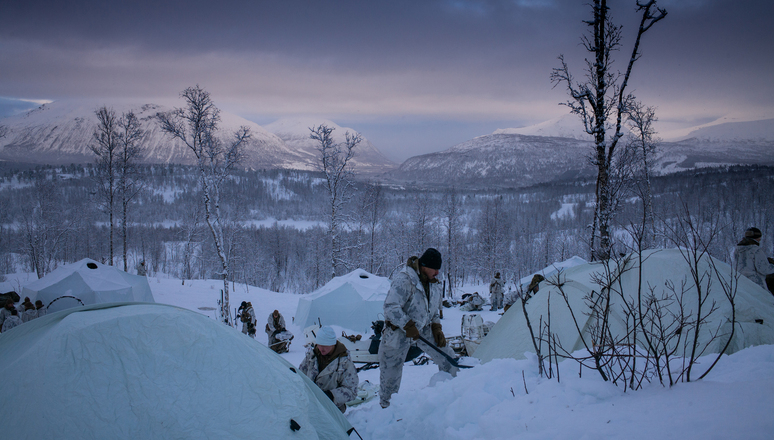 US Marines with the 1st Battalion of the 2nd Marine Regiment fortify their camp near Setermoen, Norway.
US Marines with the 1st Battalion of the 2nd Marine Regiment fortify their camp near Setermoen, Norway.
The marine looks down at his skis as if they’re going to bite him.
But his comrades won’t stop taunting him – do it, do it, do it – so he lifts his chin and eyes the drop before him with resolve. He plants his poles in the snow and pushes.
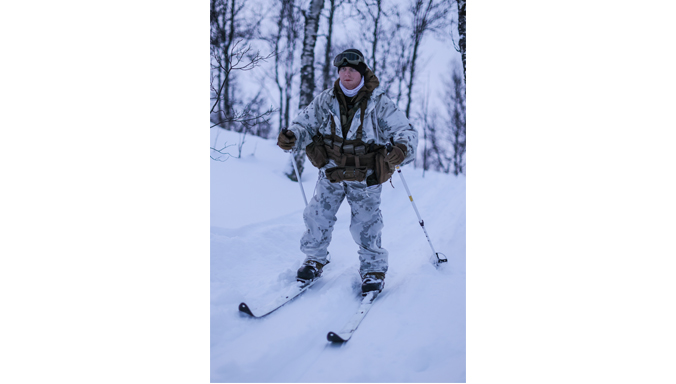 A US Marine trains on skis near Setermoen, Norway.
A US Marine trains on skis near Setermoen, Norway.
The marine glides down the slope – more like a dent, really, in the crown of this snowy hill in northern Norway – and almost reaches the bottom when his skis leap out from under him, sending him crashing onto his back.
His friends erupt in cheers, raising their mittened hands. The marine groans.
“Every time, I fall on my a**,” he says, using a word we can’t repeat on the NATO website.
Like many of the troops in 1st Battalion, 2nd Marine Regiment (1/2 for short), he’s never been on skis before. This 10-day cold weather training course, held in the hills near Setermoen in February 2024, is a trial by ice, designed to help the marines survive the extreme elements of the Arctic Circle. In a matter of weeks, 1/2 will be well north of here, landing on the frozen coasts of Norway’s remote Finnmark region, for exercise Nordic Response.
Norway has long been a cold-weather proving ground for NATO Allies. The “Cold Response” series of exercises began in 2006, building off a long legacy of cold-weather training in Norway. Since then, the exercise has taken place in northern Norway every other year.
Following NATO’s enlargements with Finland and Sweden, the Norwegians are now expanding the exercise and renaming it “Nordic Response”. It involves over 20,000 soldiers, 50+ ships and 110+ aircraft from more than 14 countries.
The fallen marine rises to his skis and duck-walks back up the hill. He might be grimacing now, but by the time the exercise starts, he’ll be skiing through the frozen landscape with ease, a rifle slung across his chest and a 30-kilogram rucksack hugging his back.
“I think that’s one of the things that we see with our marines and sailors in this training,” said Marine Lieutenant Colonel Ted Driscoll, 1/2’s Commander, “is how rapidly they can gain skills to meet a level of proficiency necessary to execute operations. But like anything, it just takes practice”.
Unless, of course, you were born here. Many Norwegian soldiers enter military service with plenty of cold-weather savvy, and they move through the punishing terrain with style, whether by ski, snowshoe or snow mobile. They see the uncompromising rigour of their great, snowy backyard as a valuable proving ground for NATO’s forces.
“Being in Finnmark, in the harsh temperatures, cold temperatures, lots of snow, it’s very hard to operate,” said Lieutenant Colonel Petter Bakkejord, Commander of the Norwegian Army’s Armoured Battalion, Brigade Nord. “That will enable us to operate anywhere in the world. It could be desert, it could be tropical areas, but the Arctic prepares you for most environments.”
Which is to say: if you can make it here, you can make it anywhere.
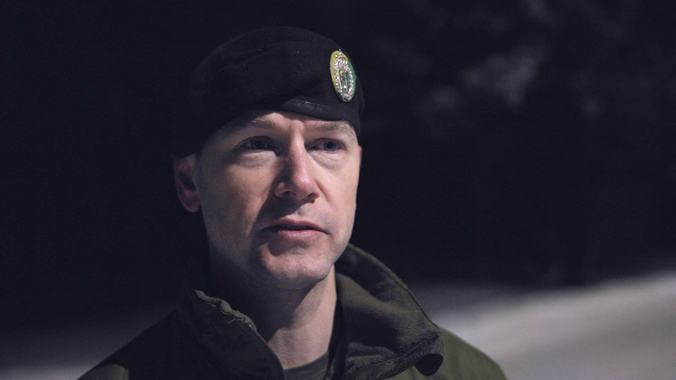 Lieutenant Colonel Petter Bakkejord, Norwegian Army.
Lieutenant Colonel Petter Bakkejord, Norwegian Army.
Not that you need to tell the marines. In the past decade, the US military’s amphibious force has dedicated itself to mastering arctic warfare, sending scores of troops to learn the harsh lessons of winter in Setermoen. They’ve had good teachers in their Norwegian counterparts, and also the United Kingdom’s Royal Marines, which have a relationship with the Norwegian Arctic that predates NATO itself (in 1941, Royal Marine Commandos raided the Axis-occupied Lotofen islands, not far from Setermoen).
At their hilltop camp, you could see years’ worth of lessons learned being put into practice. For example: a marine shovelling snow into a yellow plastic bag. What might look like a menial chore is, in fact, the most important task in the camp. Snow gets melted and then boiled into clean water, which cooks food and hydrates marines. If someone isn’t digging a fighting position, brushing snow off their weapon or tuning skis, they’re shovelling snow into bags, or turning snow into water.
The trick is to keep busy. There’s always something to do, and doing that something generates body heat, keeping the -20 degrees Celsius (-4 degrees Fahrenheit) cold from numbing their toes and fingers. One sergeant proudly displays a shoulder-height wall of snow that his marines built around their yurt. It keeps the wind off the tent, he explains, but it also kept his marines moving, their bodies warm and their minds occupied.
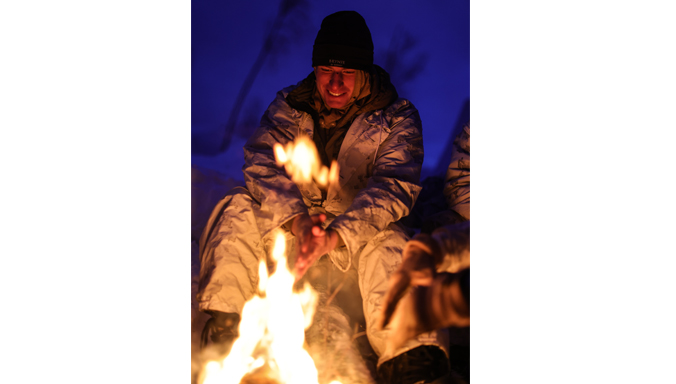 US Marines warm themselves by a fire near Setermoen, Norway.
US Marines warm themselves by a fire near Setermoen, Norway.
Everything takes longer in the snow. Hikes that should take a couple of hours turn into a half-day effort, with marines stopping to tighten their snowshoes and get their bearings in the blank Arctic landscape. Even with snowshoes, hauling equipment through the terrain is exhausting. And there’s more equipment to haul: heavy tarps, diesel fuel for the tent stoves, skis and snowshoes, gloves the size of oven mitts and puffy jackets that the marines derisively call “snivel gear”.
And then there’s the cold.
The cold creeps through tent openings, finds its way down collars and seeps through knit caps. Stay still long enough, and you’ll lose feeling in your fingers and toes. Don’t break a sweat, though – wet clothes can cause frostbite, or hypothermia. Before a training attack, one corporal ordered his marines to strip their snivel gear; he didn’t want them soaking their undershirts as they charged through the deep snow, sweating with effort.
The order seemed counter-intuitive, and as the marines stripped down and removed the warm, puffy jackets, you could see them tense slightly as the cold air blasted the warmth off their bodies. But they ignored the shiver, yanked on their white camouflage overcoats and picked up their rifles. Soon, they were charging up a hill, their snowshoes flinging clouds of frozen powder.
The Arctic is a harsh teacher, and there’s still a long way to go until they reach Finnmark, but the marines are quick studies. For those new to snow and unsteady on skis, practice might never make perfect – but it can certainly make good enough. And with NATO Allies who are experts in Arctic survival, the marines will always have friends to help them weather the cold.
Source: nato.int

